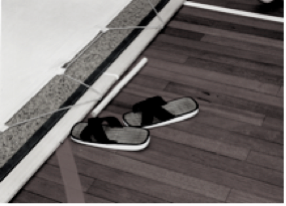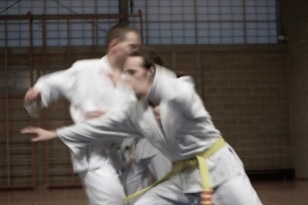what is aiuchi?
We are part of the Aiuchi Jiu Jitsu Association. Aiuchi jiu jitsu is a ‘gendai’ or modern style of Japanese jiu jitsu. We focus on self-defence rather than sport. Most of what we do is standing - looking at defences from kicks, punches, grabs and various weapons. We want to avoid or disarm an attack and escape.
We spend a lot of time on ‘situational’ self defence - looking at common or likely attacks and how we might defend ourselves against those. As a consequence you will see many techniques that might be familiar from other martial arts or other types of jiu jitsu - for example locks that you might have seen in aikido, throws from judo or groundwork from Brazilian jiu jitsu.
We try to use an opponents strength and momentum against them rather than meeting force with force. We are not seeking to teach you how to be an MMA champion or cage fighter or to defend against a trained fighter. Fighting needs a very different strategy to self-defence.







history of aiuchi
For a relatively modern style, aiuchi’s history is a little confused, but there are clearly influences that point to some aspects originating in Japan, with other influences, including Western and European. It is a modern (or gendai) style of jiu jitsu, not a koryu art.
In order to understand the style it is necessary to realise that the transition from its probable roots in Japan to that practised in Britain today have relied on the understanding, and memories of several key men. These men were human, and in passing on their knowledge there has been much room for alteration, as well as the refinement and evolution of technique that is its strength. In view of this the senior instructors continue to review the knowledge as it has been provided to them. The core elements of the style are fluid, dynamic and practical, but there is also room for improvement.
There is some influence from certain other arts too, which is explained by the lineage of the instructors who developed it and those who brought it to Britain from Japan via Australia and Germany.
The first place to start in understanding the history of aiuchi is with Matthew Komp. Komp originally learned judo, jiu jitsu, aikido, wrestling and boxing as a young man in Germany. Komp had been taught judo and jiu jitsu by his instructor in Cologne (Alfred Hasemeier). He was later taught by another German (possibly called Wolfe) who it was said had trained in Japan prior to the Second World War. The style of judo taught by Hasemeier, and then Komp was probably influenced by Kenshiro Abbe (note: possibly Ichiro Abe). Abbe was a teacher of some renown, who spent some years teaching judo and aikido in mainland Europe before being invited to Britain in 1955. Komp’s history is a little confusing and retains a little of its mystery, even though we have spoken to him about it!
Komp, who had trained as an engineer, emigrated to Australia in 1953, where he established his judo school in Melbourne. It is unclear which style, or styles, of jiu jitsu Komp was taught. There seems to be a marked judo influence, presumably from Kenshiro Abbe, and verbal history suggests that the jiu jitsu hails from the Kodokan.
One of Komp’s students was a Yorkshireman called Brian Graham. Graham began training in judo and jiu jitsu with Komp in Melbourne, Australia in 1957 and was awarded his Shodan in 1967. Komp's dojo was a centre for many martial arts, and often attracted visiting instructors from Japan and Korea. He maintained connections with Akira Miura (also referred to as Riukia or "Rocky" Myura), who taught a number of judo seminars in Australia, and was involved in judo training for the Tokyo Police. Anecdotal accounts suggest that on a visit to Japan, Komp’s style of jiu jitsu was likened to Shorinji Kempo. There does not appear to have been any link between Komp’s jiu jitsu (that he referred to as German jiu jitsu) other than they both had similar objectives. Komp died in the summer of 2017, aged 89. He had been awarded his 10th dan.
Graham returned to the UK in 1967 and opened a club in Keighley teaching what he called Shorinji Kan Jiu Jitsu. One of his students was a boy called Peter Farrar. Farrar began his jiu jitsu career in 1969 at the age of 9 and refined Graham’s jiu jitsu. Farrar and Graham had very different physiques, and very different styles of jiu jitsu. Graham's smaller stature meant that his techniques were typically short, punchy, simple and effective. It is in Farrar we see more of what we know today as aiuchi emerging. While Graham had developed his own very effective style of jiu jitsu, and had run a successful dojo in Keighley for many years, it was his student Farrar who had the flair and charisma to build the club into a large organisation. Farrar first opened a club in Plymouth, and from there began building Shorinji Kan Jiu Jitsu. Farrar’s students opened up their own clubs all over the country. The National Samurai Jiu Jitsu Association was established to administer the style of Shorinji Kan. This later became the Jitsu Foundation, which in turn became The Jiu Jitsu Foundation (TJJF). Sadly, Peter died in 1998.
The founding members of aiuchi began their jiu jitsu careers with Farrar in TJJF, before deciding that they wanted to take a different approach to their jiu jitsu. As such students of aiuchi will see a great deal they recognise in TJJF and vice versa. Whilst there are differences in approach and philosophy, many of the techniques are still very similar.
In 1993 Simon Parker-Leehane began the East Midlands Jiu Jitsu Association in Derby. At the same time, Julian Straker-Jones was also establishing a new jiu jitsu organisation with other senior instructors (including Alan Chappell, James Hourihan, Martyn Kingsbury). The two had the same objectives, philosophy and approach and merged under the East Midlands Jiu Jitsu Association name. The name aiuchi was adopted in 1995. To complete the circle, Komp visited the UK and aiuchi on two occasions, including overseeing the grading in which Julian Straker-Jones was awarded his 4th dan in 2001.







“Fighting is what happens
when people carry on playing after you've taken away the ball .”
Mark Law, The Pyjama Game.
“ Stop trying to hit me and hit me!.”
Morpheus, The Matrix
“Use only that which works, and take it from any place you can find it.”
Bruce Lee
“ Best block, no be there."
Mr Miyagi



